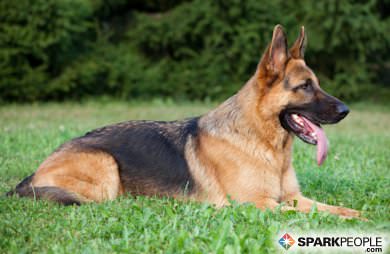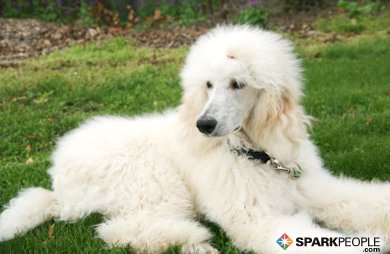|
Mixed-breed dogs make up more than 50% of all the dogs in the United States, so technically "mutts" are the most popular dog in America. A survey of these mixed-breed pets in 2010, which included 36,000 DNA tests, revealed the most popular breeds to be: 1. German shepherd 2. Labrador retriever 3. chow chow 4. boxer 5. rottweiler 6. poodle 7. American Staffordshire terrier 8. golden retriever 9. cocker spaniel 10. Siberian husky What's interesting about this list is that it's not the same as the 2012 American Kennel Club's list of most popular dog breeds, which includes these in the top 10: 1. Labrador retriever 2. German shepherd 3. golden retriever 4. beagle 5. bulldog 6. Yorkshire terrier 7. boxer 8. poodle 9. rottweiler 10. dachshund Let's take a closer look at the breeds that made it onto both lists. Keep in mind that breed standards have more to do with looks than personality. Each individual animal will have its own personality and temperament. You can use breed descriptions as a general guide to what a dog will be like, but nothing beats spending time with the animal or its parents to get a true sense of its disposition. Labrador Retriever The lab has a reputation as a family-friendly dog that makes a wonderful pet for people with small children.  Breed Purpose: It was originally bred in Canada to help fishermen and then became a hunting dog used to retrieve game. A member of the sporting group, this breed is known to be active and enjoy the water. Breed Purpose: It was originally bred in Canada to help fishermen and then became a hunting dog used to retrieve game. A member of the sporting group, this breed is known to be active and enjoy the water.Average Size: 55-75 pounds Average Lifespan: 10-12 years Common Health Issues: Canine hip dysplasia, elbow and shoulder dysplasia, kneecap dislocation. The German shepherd is a popular pet but is also known as a police and military dog.  Breed Purpose: This breed was originally created in Germany to guard and herd sheep. A member of the sporting group, the German shepherd requires regular exercise and mental stimulation. Breed Purpose: This breed was originally created in Germany to guard and herd sheep. A member of the sporting group, the German shepherd requires regular exercise and mental stimulation.Average Size: 55-95 pounds Average Lifespan: 10-12 years Common Health Issues: Hip and elbow dysplasia. Because of their barrel-shaped chest, they can also develop gastric torsion (where the stomach becomes dangerously bloated and sometimes twisted, which would require immediate surgery). The Golden retriever is known as a loyal family companion, playful and energetic, as well as easy to train.  Breed Purpose: This athletic dog was originally bred to retrieve waterfowl for hunters and usually enjoys playing games like catch and fetch because of this. A member of the sporting group, the golden retriever needs daily exercise to manage his energy. Breed Purpose: This athletic dog was originally bred to retrieve waterfowl for hunters and usually enjoys playing games like catch and fetch because of this. A member of the sporting group, the golden retriever needs daily exercise to manage his energy.Average Size: 55-75 pounds Average Lifespan: 10-13 years Common Health Issues: Lymphoma, canine hip dysplasia, hemangiosarcoma (a type of cancer that forms in the blood vessels) and skin problems. Requiring little grooming and with a special fondness for children, boxers are popular with families. They are known to be both patient with and protective of their human companions.  Breed Purpose: The boxer was originally bred in Germany for dog fighting and hunting large game like wild boar and bison. This member of the working group needs daily exercise. Breed Purpose: The boxer was originally bred in Germany for dog fighting and hunting large game like wild boar and bison. This member of the working group needs daily exercise.Average Size: 55-70 pounds Average Lifespan: 8-10 years Common Health Issues: Canine hip dysplasia, boxer cardiomyopathy (irregular heartbeat) and subvalvular aortic stenosis (congenital heart murmur). The breed is also known to be sensitive to heat. Poodle The poodle comes in three sizes: standard, miniature and toy. Their curly coat requires professional grooming but might reduce allergic reaction in people with dog allergies. This intelligent dogs makes a good pet and is known to excel at obedience training.  Breed Purpose: The original standard poodle was first bred in Germany as a water retriever. Both the miniature and toy varieties were derived from the standard poodle as companion animals. Breed Purpose: The original standard poodle was first bred in Germany as a water retriever. Both the miniature and toy varieties were derived from the standard poodle as companion animals.Average Size: 4-8 pounds (toy), 15-17 pounds (miniature), 45-70 pounds (standard) Average Lifespan: 12-14 years (toy), 13-15 years (miniature), 10-13 years (standard) Common Health Issues: Toy and miniature poodles are prone to progressive retinal atrophy (which leads to blindness), epilepsy, Legg Perthes disease (which affects the hip joint) and kneecap dislocation. The standard poodle can suffer from gastric torsion, Addison's disease (a malfunction of the adrenal glands) and sebaceous adenitis (an inflammatory skin condition). Rottweiler This breed has a well-earned reputation as a guard dog, but rottweilers are very affectionate with their families.  Breed Purpose: The rottweiler is a working dog, originally bred to guard the sheep the Romans brought with them when they invaded Europe, then further developed in Germany. Because of their size, these dogs need to be socialized and trained early and require daily exercise. Breed Purpose: The rottweiler is a working dog, originally bred to guard the sheep the Romans brought with them when they invaded Europe, then further developed in Germany. Because of their size, these dogs need to be socialized and trained early and require daily exercise.Average Size: 77-132 pounds Average Lifespan: 8-11 years Common Health Issues: Canine hip dysplasia, elbow dysplasia, osteosarcoma (cancerous bone tumor) and subaortic stenosis (a genetic heart condition). Because of their barrel-shaped chest, they can also develop gastric torsion. Popular Dog Mixes Some breeders specialize in creating specific mixes of pure breed dogs. Because the AKC doesn't register mixed breed dogs, it's much more difficult to determine which are the most popular, but looking at the available data, these 10 mixes are common in the US: 1. golden doodle – golden retriever and poodle 2. puggle – pug and beagle 3. labradoodle – Labrador retriever and poodle 4. maltipoo – Maltese and poodle 5. yorkipoo – Yorkshire terrier and poodle 6. shihpoo – shih tzu and poodle 7. cockapoo – cocker spaniel and poodle 8. schnoodle – schnauzer and poodle 9. peekapoo – Pekingese and poodle 10. goldador – golden retriever and Labrador retriever These "designer" breeds are created specifically to be house pets rather than Working or Sporting dogs, so they typically make good companions. Dogs that include Poodle in their lineage are sometimes easier to live with for people who typically have dog allergies. Pure Breed Dogs vs. Mixed Breeds All dogs, including pure breed and designer dogs, have the potential for serious inherited health problems related to their breeds. Studies have shown that some genetic conditions including cancer, hip dysplasia and knee cap dislocation occur just as frequently in mixed breeds as in pure breed dogs, while cardiomyopathy, elbow dysplasia, cataracts and hypothyroidism are more common among pure breed dogs. However, overall, mixed breed dogs tend to live longer in every body weight category (smaller breeds live longer than larger breeds). In the end, the best way to choose a dog is to consider its breed characteristics along with the individual animal's personality. Then consider your own lifestyle. If you're active and plan to give your dog lots of exercise, a working or sporting breed dog or mix is the perfect choice. If not, a small dog that wasn't originally bred for working could be a better option. Sources American Kennel Club, "AKC Dog Registration Statistics," www.akc.org, accessed on June 24, 2013. American Kennel Club, "Breed Matters," www.akc.org, accessed on June 24, 2013. Patronek GJ, Water DJ, Glickman LT. "Comparative Longevity of Pet Dogs and Humans: Implications for Gerontology Research," The Journals of Gerontology, 1997 May; 52(3):B171-8. PetMD, "Breedopedia: Dog," www.petmd.com; accessed on June 24, 2013. PetMD, "Problems Common to Purebred Dogs," www.petmd.com, accessed on June 24, 2013. Stanley Coren, Ph.D., "A National Census of Mixed Breed Dogs," Psychology Today, June 28, 2011. Thomas P. Bellumori, MS; Thomas R. Famula, PhD; Danika L. Bannasch, PhD, DVM; Janelle M. Belanger, MS; Anita M. Oberbauer, PhD. "Prevalence of Inherited Disorders Among Mixed-Breed and Purebred Dogs," Journal of the American Veterinary Medical Association, June 1, 2013, Vol. 242, No. 11, Pages 1549-1555. VetStreet, "Are Mutts Healthier than Purebreds?" www.vetstreet.com, accessed on June 24, 2013. VetStreet, "The 20 Hottest Dog Breeds and Mixes," www.vetstreet.com, accessed on June 24, 2013. |
